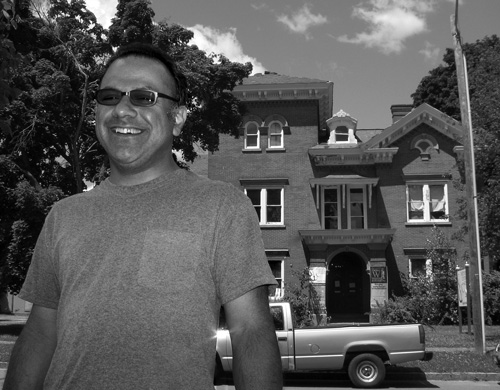News
Gift to a hometown
Couple’s efforts lead to new arts center for Pittsfield
By JOHN TOWNES
Contributing writer
PITTSFIELD, Mass.
 Over the past two years, a Pittsfield native’s desire to give something back to her hometown has resulted in the creation of a new arts center in a converted mansion in the city center.
Over the past two years, a Pittsfield native’s desire to give something back to her hometown has resulted in the creation of a new arts center in a converted mansion in the city center.
The Whitney Center for the Arts began hosting performances and exhibitions last summer in a sprawling three-story structure on Wendell Avenue, just down the block from the city’s public library.
Known informally as The Whit, the arts center is a gift to the community from Lisa Whitney, a New York City lawyer who grew up in Pittsfield.
Although Whitney left the Berkshires after graduating from high school in 1964, she maintained her connection to Pittsfield and returned regularly for visits as an adult. She still owns her late parents’ house here.
Whitney had wanted to do something for her hometown, and the opportunity arose when she learned that the 20,000-square-foot Colt mansion was on the market. Two years ago, she bought it for $225,000 with the goal of establishing a center for the arts and culture. She then began working to set up a nonprofit organization to run it.
Although Whitney continues to live in New York for her career, her husband, Ghazi Kazmi, has put his profession as a finance and operations consultant on hold to work full time launching and managing the Whitney Center for the Arts. Lisa Whitney also is involved in it as much as her schedule allows.
“Lisa was determined to do this, because she really loves Pittsfield and wanted to give something back to the community,” Kazmi said. “We talked about it and agreed that it would require our active involvement. Lisa won’t be able to retire for a number of years, and we decided that I would focus on this.”
The new arts center reflects a larger overall effort in Pittsfield to establish the Berkshires’ largest city as a regional center of the arts and cultural activity.
Kazmi said their goal for the Whitney is to contribute to that process, as an independent and self-sustaining community-based organization funded by public contributions and earned income.
The Whitney so far has been mainly self-funded by the couple, with some revenue from performances and other sources.
More events, artistic connections
The former Colt mansion is on a block of Wendell Avenue where some large old homes, converted into professional offices, sit among newer buildings that house various community organizations. It was built in 1865 by Thomas Colt, a prominent businessman and civic leader of the 19th century. In the 1930s, the Colt mansion became the headquarters for the Women’s Club of Pittsfield, which occupied it until 2010.
The building has 10 rooms. In addition to a kitchen, parlors and a dining room, the first floor features a long, open room that is used as the primary space for events and art exhibits.
Although the building is structurally sound, it did require repairs and upgrades, such as improved access for people with disabilities and other work to make it suitable for public use.
After the completion of that work and some cosmetic improvements, the Whitney opened for its first public events in June 2013. Its first presentation was a mixed-media theater piece by Pooja Prema, called “Rites of Passage,” that featured art, movement, film and music in different rooms of the mansion.
Another event last summer was Islam Contemporary, an August art exhibit staged in collaboration with the city-operated Lichtenstein Center for the Arts as part of a monthlong festival of Islamic culture.
Since then, the pace and variety of activities at the Whitney has steadily increased.
“We’re reached the point where we have an event going on most weekends,” Kazmi said.
On its own, and in collaboration with other organizations and artists, the Whitney has developed a full schedule of performance programs, including series that are presented on a monthly or semi-monthly basis.
It has become a performance base for the Town Players, a longtime local nonprofit theater organization that now regularly offers theatrical productions and readings at the Whitney. The availability of the new arts center helped to revitalize the Town Players after a period when the group had not had a stable home base.
The Whitney also presents Opera Notti, a series of concerts featuring regional performers singing arias from classical opera, along with songs from other genres.
Another series is Cabaret @ The Whit, a series of New-York-style cabaret revues performed by Ron Ramsey and Lisa Talora.
Both Opera Notti and the cabaret series are presented in an informal café-like setting, with audiences seated at tables and with wine and light snacks available for sale.
“The goal is to offer shows that are entertaining in a setting that is accessible and comfortable,” Kazmi said. “People really enjoy the relaxed café atmosphere.”
Another regular feature is quarterly chamber music concerts, although these are presented in a more formal style.
The Whitney also has gained a presence in the city’s visual-arts scene through its two art galleries.
Gallery W is located in the main performance and exhibition room and presents large-theme exhibits featuring a mix of local, national and international artists curated by Nayana Glazier. The shows in Gallery W change monthly, with different themes.
Local artists also are featured in a smaller parlor room known as the Colt Gallery, which has regularly changing exhibits.
The Whitney also participates in the visual-arts community in other ways. It holds art-show openings and an after-hours social gathering during the city’s monthly First Fridays Artswalk.
The Artswalk features simultaneous early-evening openings of shows by local artists in restaurants, stores and other sites in the city center. The Whitney’s receptions after the openings have been popular with artists and visitors to the Artswalk.
The Whitney also has hosted special events related to the arts. Earlier this year, for example, it hosted a retrospective exhibit and a public reception for John Stritch, a prominent Berkshires artist, shortly before his death.
Building a reputation
Although starting an arts center has required a steep learning curve, Kazmi and Whitney say they’re pleased with their progress so far.
“The public response has been great,” Kazmi said. “I think a lot of people have been taken by surprise that we’ve been able to do as much as we have so quickly.”
Attendance at most events has been strong, he added.
“We’ve been getting good audiences, and a number of shows have sold out,” Kazmi said.
The Whitney is beginning to build a reputation beyond Pittsfield, he added.
“We’ve been getting audience members from places like Great Barrington and Bennington, Vermont, so people are making an effort to come here,” he said.
He said he hopes the Whitney will help to dispel old stereotypes about Pittsfield.
“It bothers me when people from surrounding towns say they don’t think of Pittsfield as a cultural center,” Kazmi said. “I really think the arts scene in Pittsfield is great. When you look at everything that is here -- like Barrington Stage, the Berkshire Museum, the Lichtenstein center, the Whitney, and all of the other organizations and activities -- it’s really thriving.”
Kazmi said there are still unmet goals and challenges for the Whitney.
One goal is to offer space for art classes. The center also aims to feature more performances in different genres, along with readings and other activities.
“We hope to add more creative and social events,” he said. “I’d also like to see it eventually become a community gathering place at other times. We can offer free Wi-Fi, and it would be great if it can become a place where people can come to work outside of their home or just relax and socialize.”
Raising the profile of the art galleries is another priority.
“We’re still struggling with getting gallery traffic, Kazmi said. “Although we have some great art on display, we’re not in a highly visible location like North Street. So people don’t necessarily know we’re here or how to find us. And we’re not able to be open all the time, because we don’t have a full-time staff for the gallery.”
One possibility, he said, is to organize a schedule of volunteers.
With the aim of broadening the center’s financial base, one priority is leasing out other rooms within the building for offices or studio space.
Kazmi and Whitney also are making the building available for rental for private parties and other gatherings.
In terms of expanding the Whitney into an independent community organization, Kazmi said they are planning initiatives to build the financial base for the organization and its operations.
“When we started the Whitney, we made a conscious decision not to go to the public to ask for funds until we’ve done enough to have a brand name and demonstrate what this can become,” he said. “I believe we’ve reached that point and we’re ready to do that, so I expect we’ll begin organizing a membership and fund-raising campaign after this summer is over.”
For more information about the Whitney Center for the Arts or its programs, visit www.thewhit.org or call (413) 443-0289.

